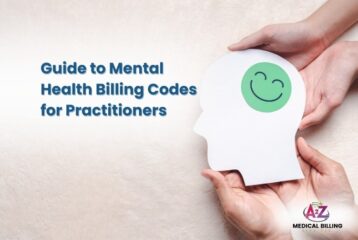In the rapidly developing field of telehealth, correct billing is more than a legal obligation. It is critical to the financial health of medical practices. Using the correct billing codes for telehealth mental health services influences payment rates, improves service delivery efficiency, and lowers the probability of costly errors. As telehealth expands, particularly in mental health, billing accuracy is directly related to healthcare services’ viability and growth.
Understanding Telehealth Billing Codes for Mental Healthcare
As we approach 2024, healthcare practitioners and billing professionals must be familiar with the most recent billing codes for telehealth mental health services. These codes are crucial because they have a direct impact on reimbursement processes and insurance compliance.
Understanding the Latest Changes in Billing Codes
| Previous Code | 2024 Code | Description of Change |
| Example: 90832 | Example: 90832 | Adjustment in the time frame for which the code is applicable from 30 minutes to 45 minutes. |
| Example: 90834 | New Code: 90834-A | Introduction of a modifier to denote services delivered via telehealth platforms. |
Important Billing Codes for Telehealth Mental Health Services
In 2024, numerous billing codes will be commonly used in telehealth for mental health treatments. These codes streamline the billing process while ensuring that mental health practitioners receive adequate service reimbursement. Understanding these rules is critical for effective practice management and the financial stability of the services supplied.
List and description of key codes
Here is an up-to-date list of the most regularly used billing codes for telehealth mental health services in 2024.
| Code | Description | Example Scenario |
| 90791 | Psychiatric diagnostic evaluation | Initial consultation via video call |
| 90832 | Psychotherapy, 30 minutes with a patient | Follow-up therapy session, 30-minute duration |
| 90834 | Psychotherapy, 45 minutes with patient | Longer therapy sessions, typically for moderate cases |
| 90837 | Psychotherapy, 60 minutes with patient | Extended session for more complex cases |
| 90847 | Family psychotherapy with the patient | Family therapy sessions including the patient via telehealth |
| 90853 | Group psychotherapy | Conducting a virtual group therapy session |
| H0031 | Mental health assessment, by non-physician | Assessment conducted by a licensed counselor |
Applying Codes in Real-world Situations
Consider the following examples to see how these telehealth mental health billing codes are used in real-world scenarios:
Code 90791: Used for an initial diagnostic evaluation over a video conference, which may include a clinical interview and early assessments.
Code 90834: Suitable for frequent 45-minute treatment sessions via telehealth, with talks and therapeutic interventions suited to patient needs.
Code 90837: Used when a session lasts 60 minutes or longer and is frequently utilized for more intensive therapeutic interventions or complex case discussions.
Addressing Changes in Telehealth Billing for Mental Health
Telehealth, particularly in mental health, is always evolving. The year 2024 has brought about numerous important changes to the billing codes for telehealth mental health services. These developments reflect the continuing alterations in healthcare delivery brought about by technological advancements and transformations in patient-care methods. Understanding these developments is critical for healthcare professionals to ensure compliance and accurate billing.
Implications of Recent Billing Code Changes
Recent billing code adjustments can have a substantial influence in various areas:
Reimbursement: Incorrect code usage can result in denials or delays in reimbursement.
Compliance: Agreement to the updated codes is required to comply with health insurance policies and regulations.
Operational Efficiency: A thorough understanding and application of the new codes improves the operational efficiency of billing operations.
Adapting to changes in Telehealth Billing Codes
Moving to new billing codes necessitates a proactive approach. Here are some strategies for efficiently managing these adjustments.
Regular Training: Schedule regular training sessions for your billing personnel to keep them up to date on the current billing procedures.
Use Technology: Implement advanced billing software that automatically upgrades to include new codes.
Stay Informed: Keep up with the latest news from important healthcare regulatory authorities and insurance.
Key 2024 Billing Code Changes
To assist in visualizing these changes, below is a table summarizing key updates in telehealth mental health billing codes:
| Code | Previous Requirement | 2024 Update | Impact |
| 90832 | 30-minute session | 30-minute sessions clarified to include preparation time | Enhances clarity on billable time |
| 90834 | 45-minute session | 45-minute code now includes follow-up notes time | Broadens the scope of billable activities |
| 90837 | 60-minute session | Modifier for extended telehealth session added | Allows for extended telehealth-specific sessions |
Best Practices to Use Telehealth Mental Health Billing Codes
Accurate coding is essential for compliance and reimbursement in telemedicine mental health services. For maintaining accuracy while using billing codes, it is critical to stay up to date on any modifications or adjustments to coding requirements. Implementing checks and balances throughout the invoicing process can protect against errors that could result in claim rejections or audits.
Strategies to Maintain Accurate Billing
Regular Coding Updates: Make sure the billing staff attends training sessions and webinars regularly to stay up to date on the most recent billing codes for telehealth mental health.
Use Certified Software: Invest in healthcare billing software that is constantly updated with the most recent code updates and has capabilities that detect common coding problems before submission.
Double-Check System: Implement a routine double-check method in which multiple team members verify codes and claims to identify any mistakes early.
Common Billing Errors and How to Avoid Them
Misusing Modifiers: Improper use of modifiers for telehealth services might result in refused claims. Ensure that any suitable modifiers are well understood and correctly used.
Not Staying Update: Failure to incorporate new billing codes into the system swiftly can result in the use of out-of-date codes. Regular billing code changes and audits should be a top priority.
Incorrect Patient Information: Simple inaccuracies in patient data can result in claim denials. Always thoroughly verify patient information before submitting a claim.
Tips to Enhance Accuracy in Billing Codes
| Tip | Description | Impact |
| Update Training | Regularly train staff on new billing codes | Ensures all billing is up-to-date and compliant |
| Invest in Technology | Use advanced billing software | Reduces errors through automated checks |
| Implement Double-Checking | Have multiple eyes review claims before submission | Catches errors that could lead to claim denials |
Technology and Tools to Improve Billing Efficiency for Telehealth Mental Health Services
Overview of Software and Tools for Accurate Billing.
In the field of telemedicine mental health, the correct technical solutions can significantly improve billing efficiency. Modern billing software not only allows for the proper use of the most recent billing codes for telehealth mental health, but it also streamlines the entire billing process. These solutions include features like automated code upgrades, error-checking algorithms, and the ability to integrate with other practice management systems.
Key Tools for Telehealth Billing
Electronic Health Records (EHR): Integrates billing and patient care documentation.
Medical Billing Software: Medical billing software is specifically developed to handle complex coding and billing cycles.
Claim Scrubbing Tools: Automatically checks for problems before submission, lowering the risk of denials.
Advantages of Integrating Technology into Your Billing Processes
Implementing modern technologies into your billing procedures has various advantages. Not only does it eliminate the manual work required for billing duties, but it also improves accuracy and speeds up the reimbursement process.
Advantages of Technology Integration
Increased Accuracy: Automated systems minimize human error in code entry and claim filing.
Enhanced Efficiency: The billing process is streamlined, making it faster and more reliable.
Compliance and Up-to-date Practice: Ensures that billing processes comply with current regulations.
Comparing Traditional vs. Technology-Enhanced Billing
To better illustrate the impact of technology on billing efficiency, here’s a comparative table:
| Feature | Traditional Billing | Technology-Enhanced Billing |
| Code Updates | Manual updates | Automatic real-time updates |
| Error Checking | Manual checks | Automated error detection |
| Claim Submission | Multiple steps, slower | Streamlined, faster process |
| Compliance | Risk of outdated practices | Ensures adherence to current regulations |
Let’s Recap
Mastering the revised billing codes for telehealth mental health is about more than simply compliance; it’s also about improving practice management and optimizing your services’ financial workflow. As we approach 2024, practitioners, billing experts, and healthcare consultants have to understand and efficiently utilize these codes. This expertise will ensure that your practice not only meets compliance requirements but also survives in an increasingly digital healthcare environment.
FAQs
What are the new billing codes for telehealth mental health in 2024?
The 2024 update includes several new codes and modifications to existing ones to enhance billing accuracy.
How do billing codes for telehealth differ from in-person services?
Telehealth codes often include specific modifiers that distinguish them from in-person service codes, reflecting the remote nature of the service.
Where can practitioners find the latest updates on telehealth mental health billing codes?
Practitioners should regularly check official CMS updates or subscribe to industry newsletters for the latest coding changes.
Why is accurate billing critical for telehealth mental health services?
Accurate billing ensures proper reimbursement and compliance with insurance regulations, and supports practices’ financial health.
What tools help with the application of telehealth mental health billing codes?
Advanced billing software and EHR systems updated with the latest telehealth coding changes are crucial for accurate application.



